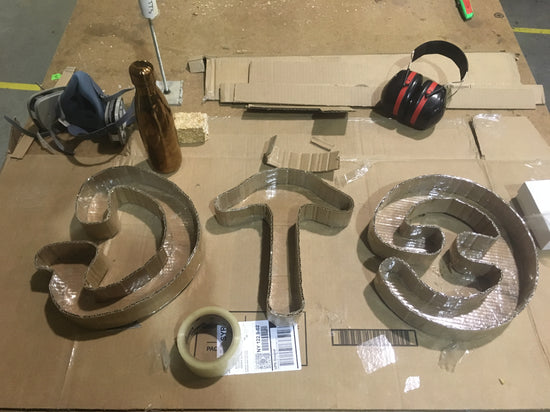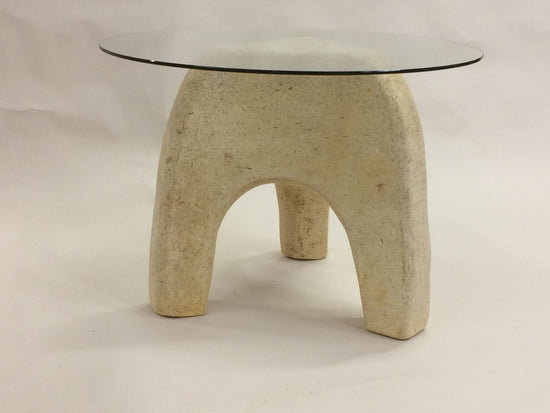Are you excited about creating your own unique designs using Ecovative's GIY material? Have designs in mind but are unsure which growth form to choose? Don’t worry! In this blog post, we explain everything you need to know about creating the growth forms that bring them to life.
But first, let’s understand the mycelium material you’re working with:
IMPORTANT
- Start by reviewing the GIY Instructions for the best results in the growth process.
- To make your growth form, refer to our easy-to-read Forming Guide and Design Considerations for best practices.
- Still have questions? Our FAQs page has the answers to the most common ones.
Growth form making- Techniques
Items you can find at home
Look around your house, visit a flea market, or simply go to your kitchen! The best found objects for growth forms are those with a nice smooth surface, like plastic or glass. Other frequent suggestions from our GIY community include Pyrex nesting bowls, cups, ceramic plant pots, and takeout containers.
Found forms
Once you know which shapes make good growth forms, you'll start to notice them all around you! One of our favorite examples is the pavilion that RPI students made using 5 gal buckets and an interior shape that created a donut-like end result. The 'donuts' were then woven into a big, beautiful outdoor shade structure, with a wooden frame for structural support.

Another option is to add sculpting mix to our GIY material and pack onto another shape. We used this method to grow a science class-style volcano over the spring!

One last ideal found material for growth forms is injection molded plastic, which often have a slight draft angle and an open face underside, making them ideal for packing in GIY material to replicate the shape. We do this with seed starters, to make our own biodegradable versions that aid in plant growth and build soil instead of going into the trash! These kinds of found shapes can also be re-used hundreds of times, making them highly economical.

Ceramics
Plant pots often stack very nicely, making them great as for found growth forms. For example, you can use plant pots to create more plant pots – just fill the bottom and sides of a plant pot with GIY material, then place a second planter on top. Another approach is to take a large bucket, and place a plant pot upside down inside of it. Fill the bucket with GIY material around the plant pot, until the bucket is full. Wrap it and let grow for 5 to 6 days, then flip the bucket upside, pop out the GIY, and remove the plant pot. You get a plant pot vessel shape just from filling in the negative space!
For one of our projects, we had extra material after growing a test bag of GIY material. Lining the wide mouth ceramic pot with plastic wrap, we filled it with GIY material, then placed a glass pyrex bowl on top to create a smooth surface for the mycelium to grow against. The result was a somewhat chunky fruit bowl shape!

Cardboard
Want to get more creative and work with more complex shapes?
Cardboard growth forms allow you to create custom shapes with just a kraft knife and packaging tape. Start constructing your growth form by cutting your wall height and folding it into shape.
To ensure a waterproof barrier, line the inside of your cardboard with plastic wrap or packaging tape. If you skip this step, the mycelium will grow into the cardboard, and/or the cardboard could contaminate your mycelium! Waxed cardboard, like material often found in takeout boxes, offers an excellent extra layer of protection. With these rules in mind, let your imagination run wild and explore different possibilities for creative growth forms!


Wood
Wood is a great material, because there is no need to make a sacrificial form — just construct your growth form, and pull apart to remove your fully grown shape. Wood is also porous, though, and a natural material that mycelium will turn into a tasty treat. That is why it must be either sealed with a water-based poly (we like Minwax), or lined with plastic wrap to prevent the mycelium from growing into the wood.

Note: Mycelium will grow into the wood, which is one of its natural food sources. Luckily, you can use this to your advantage. For example, we make stools by growing mycelium around and into a wooden base. The mycelium holds it in place, which creates a screw hold surface that is much better than screwing directly into the mycelium composite alone! If you want the mycelium to grow into wood, you must first soak the wood in a hydrogen peroxide bath (10 parts water to 1 part hydrogen peroxide), sanitizing and preventing contamination of your GIY material.

Silicone
Silicone is an excellent, non-porous material to use for casting GIY material. Depending on your experience level, you can either use off-the-shelf silicone molds, such as for casting candles, resin, or kitchen bakeware like a loaf pan. We tested some silicone molds with a wide fill surface, but some needed to be cut along the seam to be able to fill with material and extract the grown shape without causing damage. Because the walls are flexible, it's easy to distort the shape when filling and handling the form. With silicone, take a moment to re-settle the GIY material so it is flush with the walls and the fill surface is smooth.



Note: tape and plastic film don’t stick to the silicone very well. Use enough to be able to wrap the plastic film back onto itself and do a second layer if necessary. Rubber bands come in handy, too. The goal is to avoid gaps, which create too much air flow that dries out the material and prevents it growing in that spot. Without such gaps, the material will grow more consistently.
If you want to create your own custom silicone mold, we recommend Smooth On brand or another platinum based silicone. Tin based silicone seems to have an adverse affect on the exterior finish of the finished mycelium shape. Nora, an avid GIY-er and sculptor, made a custom silicone form for her mycelium Karas, and shared her tips and tricks in this GIY forum post.
3D Print
3D printing is one of the best methods to make your own custom designed growth form with a non-porous material. Luckily, over the last few years 3D printers have become very common! Because GIY material uses an open-faced mold casting technique, it is important to first design your shape, and then create the shell of the shape. This leaves an open volume in the underside that is perfect for packing in the GIY material.
We go into deep detail about using Fusion 360, material properties, design constraints, and more in our Engineering curriculum, also linked at the bottom of our Education page.

Have any tips to share? Post them in our GIY Community Forum!




